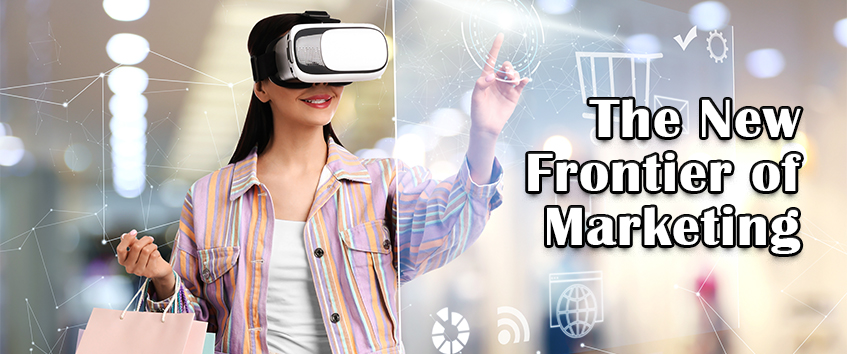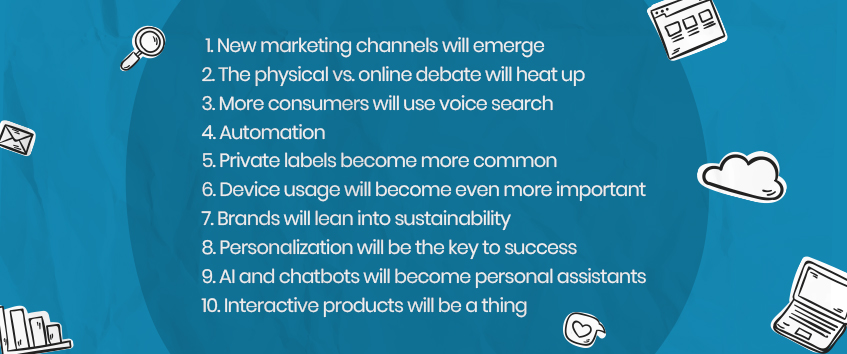Top Ecommerce Trends Shaping the Digital Marketplace
July 14, 2023
Electronic commerce, sometimes known as e-commerce, has drastically altered the way we buy and sell goods and services. Online retail establishments, online marketplaces, digital payment systems, and a variety of other online platforms are all included in the phrase buying and selling of goods or services over the internet.
The emergence of e-commerce has revolutionized the experience of buying from conventional physical shops by putting a worldwide market at our fingertips and providing convenience and accessibility. Consumers may browse, compare, and buy things with a few clicks now from the convenience of their homes, anytime and anywhere. E-commerce has provided businesses with new opportunities, allowing them to reach a larger consumer base, broaden their market reach, and run their operations round-the-clock. New business models have emerged as a result, including dropshipping, subscription-based services, and online marketplaces, enabling small firms and entrepreneurs to succeed in the digital economy.

Technology advances, secure payment gateways, enhanced logistics, and shifting consumer habits have all contributed to the expansion of e-commerce. The future of retail and commerce is being shaped by ecommerce due to the rising smartphone prevalence, improved internet speeds, and changing customer expectations.
This blog will explore numerous facets of e-commerce while examining the most Recent Trends, Strategies, Opportunities and Threats in the online industry. We will investigate the effects of personalization, emerging technologies, mobile commerce, customer experience, and other significant elements that influence the ecommerce landscape. The blog also strives to offer insightful information and advice to help you succeed in the digital economy, whether you’re a business owner, marketer, or simply interested in the world of ecommerce. Let’s start this adventure into the fascinating world of e-commerce and explore its potential for both customers and companies.
Major E-Commerce Trends
The world of ecommerce is constantly evolving, driven by technological advancements and changing consumer behaviors. To stay competitive, businesses need to be aware of the latest trends shaping the digital marketplace. So let’s explore some of the key e-commerce trends that are revolutionizing the industry:-
1. Mobile Commerce Takes the Lead
With the widespread use of smartphones, mobile commerce continues to dominate the ecommerce landscape. Businesses must optimize their websites and shopping experiences for mobile devices to cater to the growing number of mobile shoppers.
2. More ways to pay
When it comes to payment options, customers have different requirements, but if they can’t make a purchase on an e-commerce website in the manner they choose, they can back out of the deal. Conversion rates on mobile devices can be raised by providing a range of payment options. Additionally, if clients can save their payment information on your website, they’ll be able to check out even faster the next time they buy something.
3. Rise of Omnichannel Retailing
Omnichannel retailing integrates various online and offline channels to provide customers with a seamless shopping experience. This trend emphasizes the importance of consistent branding, personalized interactions, and smooth transitions across different touchpoints.
4. Personalization and Customer Experience
Customers now expect tailored experiences when shopping online. Ecommerce platforms are leveraging data analytics and AI-powered algorithms to deliver personalized recommendations, targeted promotions, and enhanced customer service, ultimately improving customer satisfaction and loyalty.
5. Social Commerce Expands
Social media platforms are increasingly becoming popular channels for ecommerce. Social commerce allows businesses to sell products directly through social media platforms, leveraging the power of social networks and influencers to drive sales and engage with customers.
6. Voice Commerce Gains Momentum
The rise of voice assistants like Amazon’s Alexa and Google Assistant has opened up new opportunities for voice commerce. Customers can now make purchases and complete transactions using voice commands, prompting businesses to optimize their platforms for voice search and voice-enabled shopping experiences.
7. AR and VR Revolutionize Product Visualization
Augmented Reality (AR) and Virtual Reality (VR) technologies are transforming the way customers interact with products online. By allowing virtual product try-ons or immersive experiences, businesses can bridge the gap between online and in-store shopping, boosting customer confidence and reducing returns.
 8. Subscription-Based Business Models
8. Subscription-Based Business Models
Subscription-based ecommerce models are thriving, offering customers convenience and personalized experiences. By providing regular product deliveries, curated boxes, or exclusive access to services, businesses can foster customer loyalty and recurring revenue.
9. Same-Day and Fast Delivery
Speedy delivery options have become a significant competitive advantage for ecommerce businesses. Offering same-day or fast delivery services not only meets customer’s expectations but also helps reduce cart abandonment and drive repeat purchases.
10. Influencer Marketing and User-Generated Content
Influencer marketing and User-Generated Content have become powerful strategies for ecommerce businesses. Collaborating with influencers and leveraging User-Generated Content can create social proof, build brand awareness, and increase customer trust, ultimately driving sales and engagement.
11. Sustainable E-Commerce Practices
As consumers become more environmentally conscious, sustainable e- commerce practices are gaining traction. Businesses are adopting eco-friendly packaging, reducing carbon footprints, and promoting ethical sourcing to appeal to eco-conscious customers.
How to Assess the Compatibility of an E-Commerce Trend?
Not all e-commerce trends need to be followed, but which ones are worth our time and energy? While some can significantly benefit your business, others may not be in line with our target market or may be too expensive to implement to continue generating profits for our company.
Knowing our own clients, industry, and competitors inside and out is key to determining which trends are best for us. What are the major contributing factors to determine this? Let’s look
- Keep Track of your Industry
- Utilize contemporary Digital Tools
- Analyze Your Customers & ask their Opinions
- Check out your Competitors

How Can ‘Market Trend Analysis’ Help Our Business?
We can launch new items and reposition our present ones to match shifting consumer wants by proactively identifying and adopting market trends. We will also be able to change course as the market evolves to avoid being surpassed by more trend-aware rivals.
Enhance company forecasting: By identifying patterns so that you may make changes to position yourself for tomorrow’s markets.
Obtain market leadership: Being at the vanguard of new trends can propel our company to the top of the marketplace.
Create fresh business concepts: By thinking of innovative ways to sell goods and services based on consumer demand.
Identify potential threats: By spotting new trends early on, we can judge if our business and its rivals are prepared to take the chance.
Find areas for improvement: Knowing our market helps you identify areas where our company may make improvements to better serve customer demands and wants.
Major Strategies for Successful E-Commerce Marketing
Having a good online presence and using the appropriate marketing strategies are essential for generating traffic, increasing conversions, and increasing revenue whether we are a new startup or an established company. We will go over crucial ecommerce marketing tactics here that can make us successful in the internet market.
Create an Easy to access Website: An easy to access website is the cornerstone of any effective ecommerce marketing campaign. Improve the look, feel, and navigation of our website to give users a simple and seamless experience. Make sure our website is user-friendly on mobile devices, loads quickly, and provides quick access to product details as well as a safe checkout process.

Create Unique Content: Making the content for an e-commerce website is the first step in getting it up and running. Our chances of success will increase if we provide original, high-quality content that connects with our audience and encourages them to interact with us, buy from us, and build a following. By producing and promoting original content, we can ensure that our audience receives new content that matters on a regular basis. Generally 80% of our content should be informational and only 20% promotional. All our published material should be timely, engaging and original.
Social Media Promotion: Use social media wisely to engage with our audience. We can Showcase our brand through social media platforms to promote our brand and increase our e-commerce traffic. Create our ongoing social media presence on the platforms our target audience is most active on. Interact with our followers, provide interesting content, run relevant ads, and use user-generated content to increase our business credibility and reach.
Search Engine Optimization (SEO): If we implement modern SEO strategies, our e-commerce website will rank higher in search engine results pages. We should conduct keyword research to find relevant terms and phrases that our target market uses for products. Use these keywords to improve our product descriptions, meta tags, titles, and URLs. Create high-quality content that benefits our audience and encourages linking and sharing.

Influencer Marketing and Personalization: As consumers gain more power in the e-commerce space, working with influencers who have a significant following in our field will help you reach a larger audience and establish trust. Find influencers who align with the principles of our brand and products. Join them in creating engaging content that promotes your online store. This strategy can increase brand recognition, increase credibility, and increase revenue. This means that our company needs to stand out in a distinctive way. At the same time, personalized marketing that is tailoring our user experience to the needs of our target market is more critical than ever. Both are critical components of our e-commerce marketing plans, just like our overall brand strategy.
Pay-Per-Click (PPC): It enables us to show tailored adverts to prospective clients who are actively looking for products comparable to yours. To increase click-through rates and conversions, create campaigns that are precisely targeted and optimize our ad copy and landing pages. Our PPC campaigns will work better if we regularly analyze them and make adjustments depending on performance metrics.
Make Our Website Mobile-Friendly: It is imperative that we make your website adaptable to any user interface. In order to ensure a positive user experience for everyone, it is critical to take into account the needs of mobile users, who are beginning to dominate the internet user base, particularly in e-commerce. To particularly target mobile consumers, we should additionally employ mobile marketing strategies too.
The success of our business can be greatly impacted by putting these crucial ecommerce marketing ideas into practice. To achieve long-term growth, keep in mind to consistently analyze and improve your strategy based on data and client feedback.
5 Major E-Commerce Threats
E-commerce threats arise when someone uses the internet unfairly with the goal to steal, commit fraud, or violate security. E-commerce risks come in many different forms. Some of them are the result of human error, while others are unintentional. The most typical security dangers includes:-
1. Financial fraud- The primary drawback of e-commerce is that it relies heavily on online transaction processing and electronic payments. Hackers and attackers may take advantage of the fact that e-commerce involves the digital movement of money to get access to e-commerce websites and gain financial gain from them.
2. Phishing- Phishing is a type of cybercrime in which criminals appear to represent trustworthy businesses in order to trick victims into disclosing private information like passwords, credit card numbers, or social security numbers. Phishing incidents frequently take place via email, instant messaging, or phony websites that look like trustworthy platforms.
3. Spamming- Spamming is the use of electronic messaging systems like e-mails, digital delivery systems and broadcast media to send unwanted bulk messages indiscriminately.

4. Malware- Any malicious software that is intended to penetrate into our device without our awareness, disrupt or harm our system, or steal data is referred to as malware. Malware includes programmes like adware, spyware, viruses, botnets, trojans, worms, rootkits, and ransomware.
5. Man-in-middle Attack- A man-in-the-middle (MITM) attack is a broad term for when a perpetrator inserts himself into a conversation between a user and an application, either to listen in on the conversation or to pretend to be one of the participants and create the impression that regular information flow is taking place. Personal information, including login credentials, account information, and credit card numbers, are the target of this kind of attack.
E-Commerce Security is Crucial
To execute electronic transactions safely, e-commerce systems need a specific set of protocols called e-commerce security. These make it possible to sell and buy items safely and securely via the internet.

Lack of e-commerce security causes customer’s banking credentials to be lost, user’s sensitive personal information to be leaked, and credit card frauds. Electronic payment systems are able to provide security thanks to e-commerce security, making it simple for them to process data and send encrypted payments. Today’s majority of e-commerce websites use this security. So let’s tackle the e-commerce industry fearlessly.
Exploring Exciting E-Commerce Opportunities
In the corporate world, e-commerce is currently a big development. Additionally, it provides a variety of opportunities for businesses of various sizes. Due to the constantly expanding digital market, businesses may now reach a global customer base and get beyond regional limitations. Online markets attract a wide variety of potential customers since they offer a platform for presenting goods and services. These are the primary opportunities that E-commerce is offering for the contemporary digital world:-
1. Improve business projections
Identifying trends gives us the ability to make decisions today that will position us for tomorrow’s markets.
2. Become the market leader
Being at the vanguard of new trends can propel our company to the top of the market.

3. Invent new business ventures
Understanding consumer preferences can inspire innovative ideas for new product and service offerings.
4. Determine probable risks
Early trend detection enables us to judge whether our business and our rivals are prepared to take advantage of the opportunity.
5. Find areas for improvement
Knowing the market will help us to identify areas where our company should make improvements to better serve customer demands and wants.
Future of E-Commerce
E-commerce will likely undergo a lot of interesting developments and breakthroughs in the future, affecting both consumers and businesses.
This is what could happen in the future due to e-commerce:-

It’s critical to stay up-to-date on developments in the ecommerce industry whether you’re a business owner or an employee of an ecommerce firm.
In Conclusion,
E-commerce trends with perfect coverage can help businesses refine our strategies, improve customer experiences, and promote online market growth. Strategic planning, branding, website optimisation, SEO, paid advertising, content marketing, social media marketing, email marketing, and performance analysis are just a few of the many facets of a digital marketing agency’s role in e-commerce. Their knowledge and experience help e-commerce enterprises become more visible, attract more customers, and generate more income. Monolith will definitely work with you to take advantage of new E-commerce trends and improve your online visibility.

Think Smartly & Take Your E-Commerce Business to New Heights
